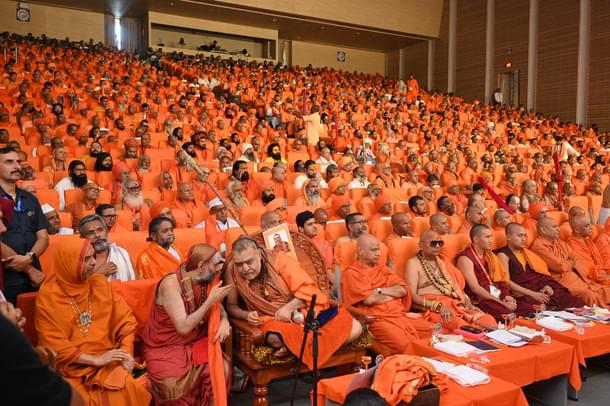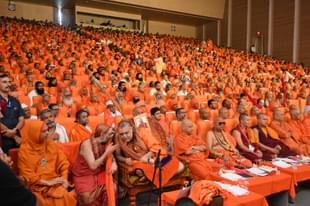Culture
Ancient Mathas Are A Bridge to Modernity: Kanchi Acharya
Aparna M Sridhar
Jul 11, 2025, 10:10 AM | Updated 10:10 AM IST
Save & read from anywhere!
Bookmark stories for easy access on any device or the Swarajya app.


Last month, in a remarkable gathering that quietly reminded the nation of its living spiritual core, over 1200 revered sants, including Mathadipathis and Mahamandleshwars, came together under the banner of the Bharateeya Santa Mahaa Parishhad in Bangalore. Among them was Sri Kanchi Kamakoti Peetadhipati Pujya Sri Shankara Vijayendra Saraswathi Shankaracharya Swamigal, whose words reflected not only Kanchi Matham’s work but also the shared responsibility of all dharmic institutions to implement the conference’s Common Minimum Programme and make it a Common Maximum Programme for the nation.
When asked about the significance of this coming together, the Acharya said simply, “The mathas have always been the guardians of dharma, but today, we must also be bridges - connecting the ancient with the modern, the local with the national, the spiritual with the social.”
At the heart of this vision, he said, is the timeless work of Veda Samrakshana – the preservation of the Vedas and Shastras through Veda Paatashaalas. “We nurture the Rg Veda, Sama Veda, Yajur Veda in our pathshalas,” he explained, “and alongside we keep alive the shastras – Tarka, Vedanta and Vyakarana. These are not relics. They are living knowledge.”
The Acharya appreciated the efforts of Sri Swayamprakasha Sachidananda Saraswathi Swamiji of Hariharapura and Sri Jayendra Puri Swamiji of Kailash Ashram, Rajarajeshwari shrine, for their effort in organising the conference. But, the Acharya was quick to add, this is not work that one Matha can do alone. Many others - from Shringeri to Dwaraka, from Puri to Rameswaram - share this vision. Together, they ensure that the Soma Yagas, the shrauta parampara, the daily rituals and deep philosophical debates are not restricted to Indian Knowledge System scholarship.
When asked how these ancient disciplines meet modern life, the Acharya pointed to the Matha’s schools and colleges. “We try to plant a seed of culture early,” he said with a smile. Mookambika, an English-medium school for families below the poverty line teaches children their ABCs in a way no Western primer would imagine: “A for Arjuna, B for Bhishma, C for Cauvery, D for Durga, E for Ekalavya.” There, children learn the ways of the world - but also remember where they come from.
This fusion of laukika vidya (worldly knowledge) and adhyatmika vidya (spiritual knowledge) was a theme echoed by other mathas too. From Samskrita Shaalas to Ayurveda colleges, they strive to ensure that India’s next generation can earn a living without losing their roots. “मातृभाषा संरक्षणं,” the Acharya emphasized, “is not optional. Our regional languages - Kannada, Tamil, Telugu - must flourish. And above all, Sanskritam must survive, for it is the mother of all.”
He added, “In this age of software,” he said, “our mother tongues are neglected. Sanskritam is our link to Ayurveda, Jyotisha, all our Shastras. We must protect it. We must speak our mother tongues at home, use English for the world, and Sanskrit in our temples. This balance is our strength.”
This integrated vision does not stop at books and classrooms. Across the country, mathas have stepped into the realm of social service, filling gaps the state cannot always reach. “We never opened old-age homes or eye hospitals for fame,” the Acharya said. “We did so because there is a need. Vidya, Ved, Suved - education, health, welfare - are our pillars.”
The Kanchi Matha alone runs 20 eye hospitals, from Karnataka to Mizoram. Surgeries are often free, giving back dignity to those who thought blindness was their fate. “When the poor see that someone cares for them,” the Acharya said, “they feel connected to society again. Patriotism begins with trust.”
Quoting Adi Shankaracharya, he recited:
गीयं गीता नाम सहस्रं
ध्येयं श्रीपति रूपमजस्रम्
नीयं सज्जन संग चित्तम्
देयं दीनजनाय वित्तम्
Sing the Gita, meditate on the Lord’s form, keep good company, and give your wealth to the poor. For the Acharya and his fellow sants, this is not just verse but instruction - a timeless upadesha.
When asked about the rising interest in spirituality today, the Acharya saw it not as an escape but as a homecoming. “People go to a medical store when they trust the medicine,” he said. “Likewise, people come back to dharma when they trust its power to heal.”
He pointed to new Veda Paatashaalas, Sangeetha Paatashaalas, Yoga and Sahitya Paatashaalas springing up even in the West, where seekers find in India’s wisdom what their own modernity often lacks: a rootedness beyond the marketplace.
The gathering of 1200 sants was not just about nostalgia for a glorious past. It was a quiet call to unity in a time of fragmentation. The Acharya spoke of the need for temples to reclaim their place as centers of learning, service, and culture. “Each Panchayat should have a Panditji” he said firmly. “Each temple should thrive like Tirupati. As WiFi connects our gadgets, pooja and pravachan connect our hearts.”
He calls for a revival of rural temples, priests in every village, अष्टावधान and शतावधान to flourish again - all drawing people together just as the sants gathered under the Parishhad banner: diverse in their sampradayas, united in spirit.
This shared vision extends to governance too. The Acharya did not shy away from reminding the state of its role. “Temples should use their revenue to support priests, musicians, rituals. The government’s duty is to enable, not to interfere. Dharma and politics must work together for national integration.”
When asked about global conflicts and the Matha’s vision for peace, he spoke of Mantra Dwara Manava Seva - serving humanity through sacred chants. In Kashmir, इन्द्राक्षी शिव कवचम् is recited for world peace. The Acharya believes that Dharma must shape business too. He contrasted the West’s profit-first mindset with India’s tendency to see the worker not as a cog but as family. “In India,” he said, “a factory feeds a thousand families. Even in loss, empathy matters. This is our Bharateeya Samskrithi.”
On the future, the Acharya dreams of a self-reliant India – Atmanirbhar Bharat - where the intellectual wealth that built NASA is harnessed at home. He wants students to feel no urge to spend crores abroad when they can find world-class education here, enriched by their own sahitya, sangeet, and samskara.
When asked about stress and the modern mind’s restlessness, the Acharya’s answer was simple but profound: “There must be love, affection, culture. A family should not be a set of individuals but a web of duties and care.” He lamented the weakening of the Guru Shishya Parampara, which once began at home. “Respect for elders, patience, the passing down of wisdom — these must return if we want peace in our families and our minds.”
He quoted the Puranas to remind one that India’s identity is in shared rivers, sacred spaces, timeless lineages:
गङ्गे च यमुने चैव
गोदावरी सरस्वती ।
नर्मदे सिन्धु कावेरि
जलेऽस्मिन् सन्निधिं कुरु ॥
“From Kashi to Kanchi, from Ayodhya to Avantika - these moksha-giving places bind us all. So too should our mathas, our families, our communities,” says the Acharya.
As the Parishhad concluded its first proceedings, it was clear that the sants did not gather to look backward but to offer India a mirror. As the Acharya put it, “We must flow like the rivers - knowledge, agriculture, technology, all together. Only then will Bharat truly be free.”
Aparna M Sridhar is a journalist.





